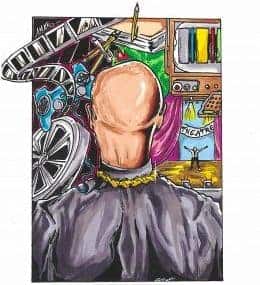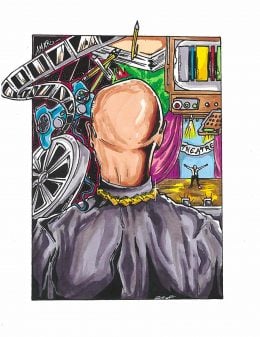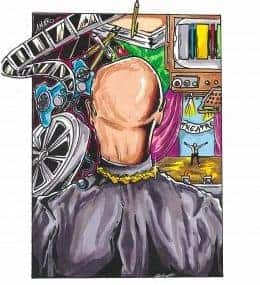The Handmaid’s Tale: Season 1/ Episode 5 “Faithful” – Overview/ Review (with Spoilers)
Many characters have their true colors revealed and, alongside this, June herself we learn isn’t as innocent as she seems. I Can See Your True Colors: Fred, June Fred, thus far, had seemed like he was just taking advantage of a bad situation. One he may or may not have agreed with based off his…

Spoiler Alert: This summary and review contains spoilers.
Additionally, some images and text may include affiliate links, meaning we may earn a commission or receive products if you make a purchase.
Many characters have their true colors revealed and, alongside this, June herself we learn isn’t as innocent as she seems.
I Can See Your True Colors: Fred, June
Fred, thus far, had seemed like he was just taking advantage of a bad situation. One he may or may not have agreed with based off his previous treatment of June. However, in this episode, he begins to peel back a layer of his personality. One which makes it seem he does believe women are better off in the roles they are today, compared to how they were in the past. Also, it seems he could very well be falling for June. If only because he makes their sex ceremony more about pleasure than impregnating her. Which, of course, worries her since all she needs is Serena Joy getting upset then she would be sent to the colonies.
Commentary
With reading B.M. Orchard’s comments on the last 4 episodes, you’ll get a sense of the differences between the book and show and with that, you realize Fred has been softened up a bit. Well, drastically actually. For so it seems, they wanted to create this false perception that he was a good guy maybe making the best of a position may be assigned to him.
We are at the beginning of the end when it comes to that. Not because he tried to make the sex intimate with June, for it is clear that Fred has no love for Serena Joy at all. Plus, in some ways, you can tell June was falling for a married man like she has done before [note]more on that below[/note]. What notes the beginning of the end is him sounding like he actually supports the regime and the idea of women only serving their biological purpose. As in, just being baby making machines. Of which is said only smug enough to make him a loveable butt wipe instead of someone you’d just completely detest.
For, again referencing B.M. Orchard’s comments, it almost seems like Fred’s whole persona was made to more so be alluring than despicable. Think of Tom Cruise’s version of the vampire Lestat. It is clear the character is an ass, but he is made into one which doesn’t lose part of his charm in the process. It is almost like they don’t want Fred to become the type of character, or any character on this show really, so strongly capable of being despised that their social media gets blown up by people who can’t separate an actor from their character.
Which is unfortunate for, just recently, Elisabeth Moss had an interview with Sam Jones, about how complex the characters are. One of the ones she highlighted was Ann Dowd as Aunt Lydia and how as villainous as she seems, you can tell she believes she is doing the right thing. Now, comparing how she describes Dowd as Lydia to Fiennes as Fred, you don’t see that sort of gray. He is written like most attractive would-be male villains are. He may represent evil, oppression, and many of the things the lead hates, but he is dangerous and, for some reason, danger is often presented as sexy nowadays.
One Way Or Another: June, Nick, Serena Joy, Emily
While Emily is out, it isn’t for long. For a few days after what has to be female genital mutilation surgery, she decides to steal a car, go for a joy ride, and kills a member of The Eye. Thus leading her to be taken away. But, this time, June likely won’t face an investigation from The Eye [note]Which she could thank the new Ofglen for since she is trying to protect her. If just because, after being the type of women who’d have sex behind a dumpster for drugs, she’d like to keep this new life she has[/note].
Emily aside, perhaps the most noteworthy thing about the episode is what happens between June and Nick. The first thing being Serena Joy arranging for the two to have sex so June can have a child. For, so it seems, her time is running out to have one and even Serena Joy thinks Fred may be infertile. So, naturally, she asks of Nick to be a sperm donor. However, what began as just business becomes so much more. For, perhaps, with June being unable to partake in enjoying sex with Fred, and him revealing his true nature, she looks toward Nick. Someone who reveals he is part of The Eye and she knows is watching her for more than business. Leading to them having passionate sex in which June gets to be in her favorite position – on top.
Commentary
There is something which seems off about what Emily did. Never mind her not driving off and trying to escape, but rolling over a member of The Eye? I get part of it was probably out of some sort of revenge and with her unable to express her sexuality, if not get pleasure anymore, she has nothing to live for, but this seemed incredibly out of character and stupid. Like they wanted her to be written off with a bang instead of a whisper. That is, assuming she does end up getting killed over this.
That aside, more and more I wonder how are wives chosen for certain commanders or men in general? For while I have no sympathy for Serena Joy, especially because her kindness is phony and purely about getting June pregnant, I do wonder how she ended up with Fred? In fact, more and more I find myself desiring flashbacks for more than just June and Moira. I’d love to see, perhaps Orange is the New Black-style, what lives these women had before the regime took over.
Heck, the men too. For something about Fred makes it seem he was written to be the last guy who ever was given a second thought yet he is portrayed by a generally attractive man. Then with Nick, there is this weirdness about him that is so alluring that you crave to know more. Making me hope that with June and him having some passionate sex, maybe she could lead him to open up a little bit. Heck, maybe we may learn something about the process of how men are given wives.
I Was the Other Woman: Luke, June
Thus far, June and Luke have been seen as a cute and ideal couple. She loves him, he loves her, they had a child and thus became perfect. However, their relationship gets tainted with it being revealed they met while Luke was married and they had an affair. One which he left his wife for to be with her, so it seems.
Commentary
Like when Fred was revealed to not be the man we thought he was, there is a slight issue with how June is revealed to not be as innocent as we thought. It is hard to explain but, it almost feels like both situations should have seemed more noteworthy than something you hunched your shoulders at. Though perhaps the problem here is tone. Even though we are probably barely scratching the surface with this show, it comes at a time when nothing it says or does can be considered shocking. Which, in a way, it seems to know so it doesn’t even try. It makes it where everything, like the changes to their world, happens little by little to the point you don’t really take much notice.
Now, on one hand, downplaying things is what keeps this show from feeling like your general network TV drama with soap opera elements. However, it does force you as a viewer to cleanse your mental palette a bit. What I mean by this is, sort of like what I noted in Loving, you have to remind yourself that there are those who don’t feel the need for dramatics. There are still productions which don’t see monologues and certain inflections to say “THIS IS REALLY IMPORTANT!” as the best means of storytelling. What they want is you to dissect and take note, perhaps re-watch certain scenes, and see things as perhaps Taraji P. Henson notes in her book. They want you to study the actor and not their theatrics.
Collected Quote(s)
Love isn’t real. It was never anything more than lust with a good marketing campaign.
Every love story is a tragedy if you wait long enough.

